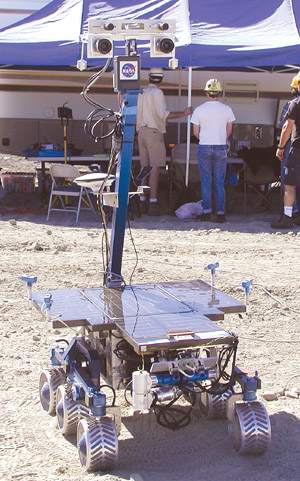Some of the first steps on the next mission to Mars are being
taken in Aromas as engineers from NASA start testing a prototype
robotic rover at the Wilson Quarry.
During the next few weeks a field team of eight NASA engineers
will be putting the robotic rover through its paces at the
Graniterock quarry in Aromas.
Some of the first steps on the next mission to Mars are being taken in Aromas as engineers from NASA start testing a prototype robotic rover at the Wilson Quarry.
During the next few weeks a field team of eight NASA engineers will be putting the robotic rover through its paces at the Graniterock quarry in Aromas.
The rover, named K-9, will be using the quarry to simulate one of the possible surfaces it could find on the face of Mars, NASA computer engineer Maria Bualat said.
The six-wheeled rover, which weighs approximately 200 pounds, will be used to examine rocks and mineral deposits on the surface of the red planet.
As it is currently planned, scientists at the Jet Propulsion Laboratory in Pasadena will operate the rover by remote control.
To simulate the kinds of conditions scientists will have to face, the prototype is being taken to various environments across the country for testing.
“We’ve done field tests in the Mojave Desert and other desert-like conditions,” Bualat said. “But we don’t tell the scientists where the rover is going.”
Just as they would on a real mission to Mars, the scientists have to evaluate the rover’s surroundings just with what they can see with the cameras and detect with the sensors mounted on it.
“They have to determine the geography of the area based solely on where they are,” Bualat said.
She said because of the distance from Mars, roughly 45 million miles, it can take up to 10 minutes for a signal to be received and responded to, so the rover has to be able to think for itself up to a point to prevent it from accidentally driving off the end of a cliff or down a gorge.
“Imagine trying to drive a car but you can only make adjustments in steering once every 10 minutes,” said NASA associate and principle investigator, Lian Pedersen “The rover will have to drive itself.”
It’s Pedersen’s job to give the rover that touch of “common sense” it will need to survive on Mars by itself.
“Once you send something like this to Mars, there will be no one there to take care of this,” he said.
Pedersen pointed out that K-9 (named after a robot in a British television series) will not be going to Mars.
“This particular rover is not going to leave Earth, but one very similar to this one will,” he said.
The rover that does go to Mars in 2009 will directly benefit from the work being done in the Aromas quarry because all the data collected and techniques developed from this and other remote tests will be used to shape the complex set of computer programs needed to operate the exploratory device.
In order to make sure the rover can function on Mars, Pedersen has been working on the computer programs needed to operate its various functions.
“That means writing hundreds of thousands of lines of (computer) code,” Bualat said. “There are different computer programs for each wheel.”
She said K-9 and its abilities will be tested for “hundreds of hours” before the information or techniques can be used in the actual Mars rover.
The exhaustive testing is needed to ensure the program will work on the rugged terrain of Mars where the temperature can range from a balmy 0 degrees Celsius during the day to a bone chilling low of -120 degrees Celsius at night.
Although much of what is contained in K-9 is cutting-edge technology, it is a far cry from the stuff of science fiction movies. There are no death rays or teleportation devices. It is simply intended to be used as a scientific research tool.
“The rover is a very complex piece of machinery,” Pedersen said. “There are 12 motors to operate the rover and it has cameras mounted on the top and sides.”
K-9 is packed with a variety of sensors and devices for detecting possible signs of life.
“The robot could look into small spaces, collecting data from inside rocks,” he said. “We know the planet had water so it could look for possible signs of life – living organisms that might actually reside within the rocks.”
The settings on the cameras are so precise and sensitive that great care has to be taken when team members are even walking by the rover.
“If the cameras are knocked out of alignment by even as much as a centimeter, it could take days to figure out how to realign them,” Pedersen said.
The field tests for K-9 are not open to the public.
The field team, which includes NASA communications engineer Tom Stone, said while Mars is a rugged desert environment it is also an impressive geological wonder that includes a mountain three times as tall as Mount Everest.
“It is so tall that it is actually brushing against the edge of space,” Bualat said.
Mars also has a gorge nearly as deep as the Grand Canyon that stretches the same distance as from New York to Los Angeles.










